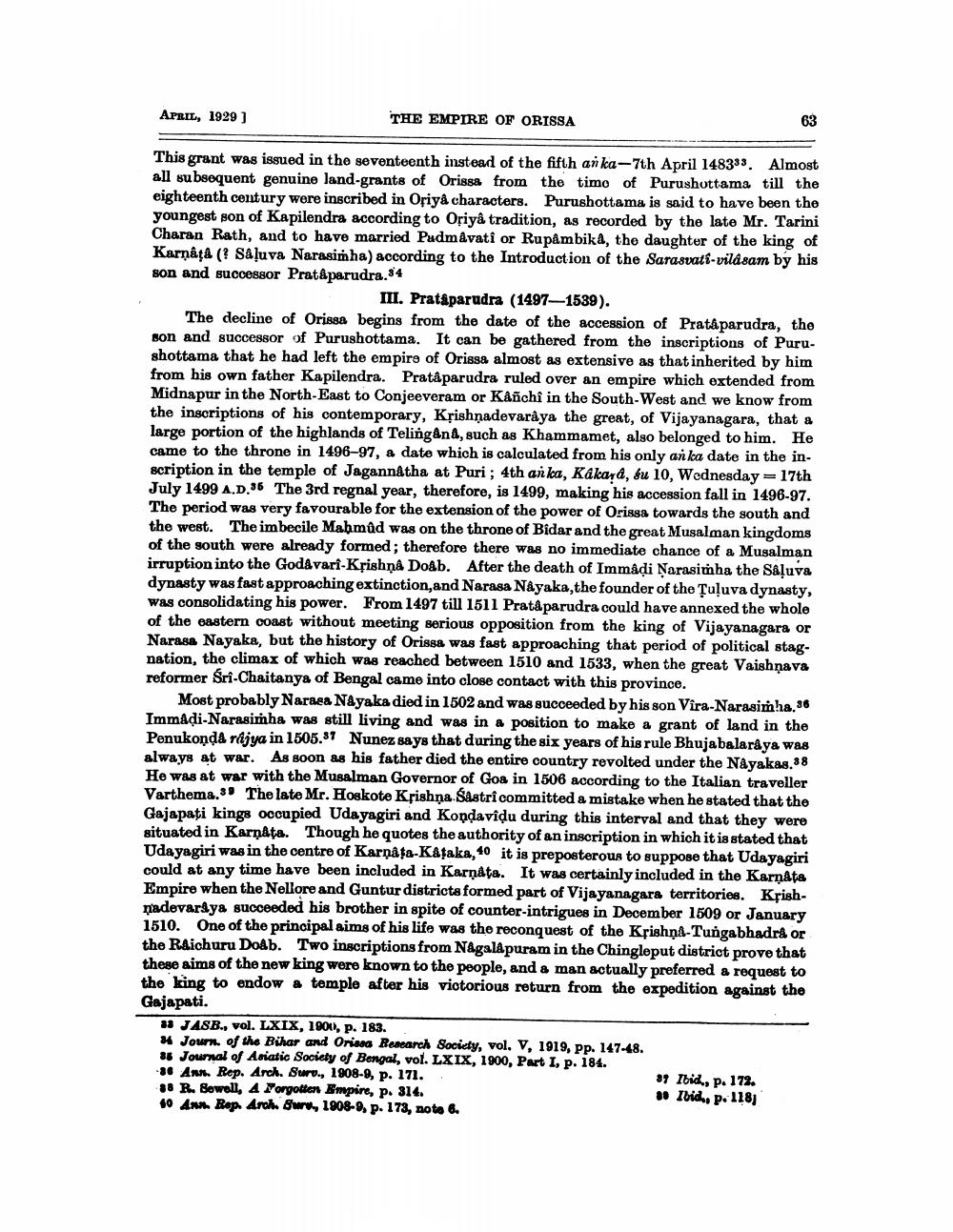________________
APRIL, 1929)
THE EMPIRE OF ORISSA
This grant was issued in the seventeenth instead of the fifth an ka-7th April 148333. Almost all subsequent genuine land-grants of Orissa from the timo of Purushottama till the eighteenth century were inscribed in Oriya characters. Purushottama is said to have been the youngest son of Kapilendra according to Oriyâ tradition, as recorded by the late Mr. Tarini Charan Rath, and to have married Padmavati or Rupambika, the daughter of the king of Karnata (? Saluva Narasimha) according to the Introduction of the Sarasvati-vild sam by his son and successor Pratâparudra.34
m. Prataparudra (1497-1589). The decline of Orissa begins from the date of the accession of Pratáparudra, the son and successor of Purushottama. It can be gathered from the inscriptions of Purushottama that he had left the empire of Oriss& almost as extensive as that inherited by him from his own father Kapilendra. Pratâ parudra ruled over an empire which extended from Midnapur in the North-East to Conjeeveram or Kanchî in the South-West and we know from the inscriptions of his contemporary, Krishnadevaraya the great, of Vijayanagara, that a large portion of the highlands of Telingana, such as Khammamet, also belonged to him. He came to the throne in 1496-97, a date which is calculated from his only an ka date in the inscription in the temple of Jagannatha at Puri; 4th an ka, Kakard, fu 10, Wednesday = 17th July 1499 A.D.56 The 3rd regnal year, therefore, is 1499, making his accession fall in 1496-97. The period was very favourable for the extension of the power of Orissa towards the south and the west. The imbecile Mahmûd was on the throne of Bidar and the great Musalman kingdoms of the south were already formed; therefore there was no immediate chance of a Musalman irruption into the Godavari-Kțishņà Doab. After the death of Immádi Narasimha the Sâļuva dynasty was fast approaching extinction,and Narasa Nayaka, the founder of the Țuļuva dynasty, was consolidating his power. From 1497 till 1511 Prataparudra could have annexed the whole of the eastern coast without meeting serious opposition from the king of Vijayanagara or Narasa Nayaka, but the history of Orissa was fast approaching that period of political stagnation, the climax of which was reached between 1510 and 1533, when the great Vaishnava reformer Sri Chaitanya of Bengal came into close contact with this province.
Most probably Narasa Nayaka died in 1502 and was succeeded by his son Vira-Narasimha.36 Immádi-Narasimha was still living and was in a position to make a grant of land in the Penukonda rajya in 1505.57 Nunez says that during the six years of his rule Bhujabalaraya was always at war. As soon as his father died the entire country revolted under the Nayakas.38 He was at war with the Musalman Governor of Goa in 1506 according to the Italian traveller Varthema.39 The late Mr. Hoskote Krishna Sastri committed a mistake when he stated that the Gajapati kings occupied Udayagiri and Kondavidu during this interval and that they were situated in Karnata. Though he quotes the authority of an inscription in which it is stated that Udayagiri was in the centre of Karnata-Kataka, 40 it is preposterous to suppose that Udayagiri could at any time have been included in Karnata. It was certainly included in the Karnata Empire when the Nellore and Guntur districta formed part of Vijayanagara territories. Ksishnadevaraya succeeded his brother in spite of counter-intrigues in December 1509 or January 1510. One of the principal aims of his life was the reconquest of the Krishna-Tungabhadrå or the Raichuru Doab. Two inscriptions from N&galapuram in the Chingleput district prove that these aims of the new king were known to the people, and a man actually preferred a request to the king to endow a temple after his victorious return from the expedition against the Gajapati.
23 JASB., vol. LXIX, 1901), p. 183. 34 Journ of the Bihar and Orions Research Society, vol. V, 1919, pp. 147-48. 36 Journal of Asiatic Society of Bengal, vol. LXIX, 1900, Part I, p. 184. -36 An. Rep. Arch. Suru., 1908-9, p. 171.
37 Ibidh, p. 172. 18 R. Sowell, A Forgotten Empire, p. 314.
** Ibid., p. 118) 10 Ann Rap Arch. Gwry, 1908-9, p. 173, noto 6.




